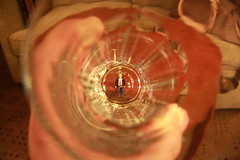 Image by betsyweber via Flickr
Image by betsyweber via FlickrAnalogy is defined as a similarity between like features of two things, on which a comparison may be based.
What I recall from learning theory, which I studied at USC in the late 1980s, is that analogy is one of our primary ways of building knowledge. As Seth Godin says in one of his blog entries, ". . realize that analogies are your best friend."
 Image via Wikipedia
Image via WikipediaDuring Biology classes, it doesn't take much for my mind to be off and riffing on all the analogies between organic molecules, cells and . . the world we live in. It's been awhile since I had the time to contemplate things like that. My mind was a virtual July 4th of synapses pondering these things when I was younger.
Most entertaining are those analogies drawn from what can be seen with the unaided eye because it's fun to look beyond mere appearances. Cell structure and functioning is akin to manufacturing - that's a popular analogy for the classroom. Social and organizational structures, interpersonal dynamics, buildings, cars, boats, planes - our inventions and the sense we make of the world around us - also are analogous to the apparently orderly scheme of things. But what if our grasp of appearances, what if that conceptual framework was determined to be . . . elementary? If the basis of our ordinary concepts were essentially all wrong, or even mostly wrong, think how that would affect . . everything.
####

No comments:
Post a Comment